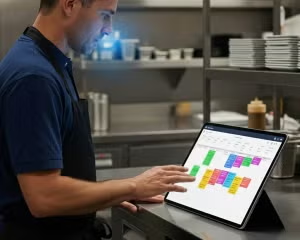In the foodservice industry, it’s a truism that you cannot cut your way to profitability. But failure to control costs will reduce your bottom line. And this applies most importantly to your prime costs.
Prime costs are a restaurant’s total food, beverage, and payroll costs for a given period, say a month or a week. Payroll costs here include wages and salaries of managers and hourly workers, including taxes and benefits.
It’s easy to lose money in your prime costs for many reasons, including spoilage, food waste, and poor scheduling.
Some operators focus much of their effort on boosting the revenue side of the equation, taking the expense side as more or less fixed. But tweaking the expense side can yield higher profitability, and often is easier to adjust than revenue.
To that end, let’s review the profitability areas, pointing out the metrics food service operators should be watching in this crucial area of their business.
Foodservice metrics of success
Cost control
Every food service business bears certain costs for food, liquor, and labor. But how do operators know whether their costs are in line with industry practice? The National Restaurant Association (NRA) publishes an annual Restaurant Industry Operations Report that provides financial data on the cost of sales, gross profit, direct-operating expenses, and other performance measurements to help you see how your operation compares with those of a similar profile. The report includes data on table-service and limited-service restaurants. Table-service restaurants are grouped by check size—under $15, $15 to $24.99, and $25-plus.
These metrics help squelch the fallacy that restaurants all are supposed to adhere to a certain fixed percentage for food or labor costs. A full-service, high-end steakhouse will pay a higher percentage of total costs on steak than a limited-service restaurant may spend on supplies. A fine-dining restaurant with a long-term professional waitstaff will pay more for labor than fast-turnover eateries. So it helps to understand through the NRA data where an operation stands in relation to its peers, rather than to the industry as a whole.
It also helps to break down your prime costs to see where money really is spent. Labor costs, for example, can include the cost of hiring (placing ads, interview time, etc.), training, weekly payroll, retraining when operational procedures change, and so forth. If a restaurant is spending more than its peers on, say, the food service training process, it helps to know why and what, if anything, an operator can do about it.
Reviewing trends and forecasting results on those trends is important because two percent per year is not much. However, if industry trends are ignored it can accelerate to 10 percent quickly.
Capturing guest reactions
In addition to cost metrics, focus on guest-satisfaction measures as a key component of profitability. Happy, satisfied guests translate into more frequent visits and higher check averages. Establish ways to capture guest satisfaction on a regular basis. If your profitability is declining even though your expenses seem in line with industry metrics, guest satisfaction measures may offer insight.
Once food service operators have a good fix on where expenses ought to be, how often should they compare their experiences against industry metrics? A best practice is to focus weekly on the prime-cost centers and monthly on guest-satisfaction measures.
Prime costs bear frequent watching because input prices can change overnight and many restaurants order their supplies more or less weekly. If the cost of a key item spikes from one week to the next, an operator can respond immediately by ordering less of it, or substituting a less expensive item. Meanwhile, watching how labor costs rise and fall with the seasons or unexpected events will help an operator learn to anticipate and control the hiring and training process for maximum cost control.
This may be a good time to say that menu flexibility is one of the most important tools for optimizing profits. The oversize, multipage, fully laminated menu with full-color photos and fixed prices is rapidly becoming extinct.
Menu sheets printed daily or weekly, or menu boards on which offerings are changed daily, permit operators to reflect changing product costs in menu prices almost immediately.
Guest satisfaction measures should be checked monthly. That level of frequency gives an food service operator the ability to notice changes in customer behavior in response to a marketing or promotion effort. Checking customer-satisfaction feedback only every six months or longer means you might miss major changes.
What’s the best way to capture customer satisfaction? That’s a whole column in itself, but it’s wise to make use of some of the old standbys, such as comment cards, and to use some of the newer opportunities offered by social media sites. For example, it’s a good idea to frequently check what customers have said about a restaurant on sites like Yelp and Facebook—and to be ready to respond when problems are spotted. Text messaging is also an option, if you use it well.
Help from foodservice distributors
Want help to pare expenses and boost customer satisfaction? Just ask your restaurant food distributor if operational tools are available as part of your primary vendor relationship. They should be.
These operational aids may include training programs on industry-specific software, warnings of likely changes in the price of supplies, and other assistance.
Also look to your independent auditor, accountant, lawyer, and banker for assistance. They may be able to help develop a plan to implement changes in your operation, or to direct you to third-party benchmarking tools. At the very least, they can act as a sounding board as you develop a plan to increase profitability.
Profitability is no accident. It stems in part from getting more guests in the door, but also from keeping a careful eye on expenses and heeding what your guests tell you about their dining experience. Food service operators who pay close attention will learn—and profit.











